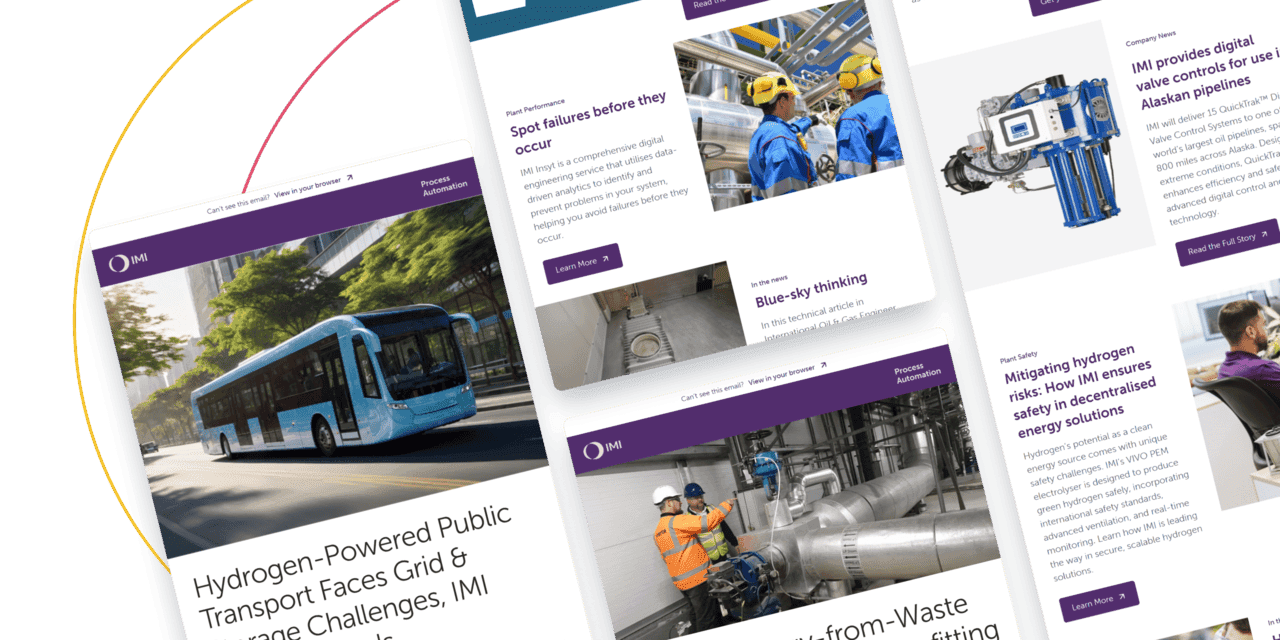Organization Sectors
Organization Sectors
Stay up to date on all the latest Process Automation news
© 2025 IMI plc, All Rights Reserved
© 2025 IMI plc, All Rights Reserved

BLOG

Written By IMI Publications
May 1, 2024
This is why IMI developed ‘Breakthrough Engineering for a Better World’ as its key purpose statement. The company’s ‘north star’ allows colleagues to assume a customer’s perspective and focus extensively on their problem or challenge. It’s also the guiding principle for Growth Hub, IMI’s innovation arm and incubator for new business ideas.
Reaching this point has been several years in the making, though, as Growth Hub manager Yogini Pekarskis explains in this blog, it has allowed IMI to become a more effective and trusted partner.
The idea of an innovation arm is not exactly new – most businesses will have an R&D department of some kind. However, the real challenge for IMI has been to frame those new and potentially game changing ideas by using our customers as the starting point. In other words, a complete rethink of new product development.This process began in 2018 following a workshop with Annemie Ress of consultants Purple Beach and Jean Gomes, author and advisor to CEOs and sixty of IMI’s most talented engineers and thinkers. The outcome from that workshop and subsequent meetings can now be read in Gomes’s book Leading in a Non-Linear World.
Since 2018, the company has overseen a series of sprint cycles and stage-gated processes focusing on real industry problems. Take hydrogen fuel. Many businesses use it during production, though often using large-scale industrial electrolysers running on fossil fuels, especially natural gas and methane.
Growth Hub looked at this problem and began working on a modular solution to bring production closer to those needing it. This work resulted in the IMI VIVO PEM electrolyser, which has immediately impacted research institutions and industry.
Centralised production was identified by our team as a significant barrier to green infrastructure despite there often being the will and investment to expand clean hydrogen projects. So, it was critical that the solution was capable of integrating renewable energy sources and onsite storage. This eliminated the standard stumbling blocks many customers face when transitioning from natural gas.
This is just one example of how IMI has used customer centric thinking to break common industry bottlenecks, laying the groundwork for future growth in a rapidly developing market. And it’s now paying dividends. At the end of 2024, IMI agreed to supply additional electrolyser technology to a German research institute and for use at a Latvian port, supporting the drive toward decarbonisation.
Another example comes from the University of Sheffield’s Sustainable Aviation Fuels Innovation Centre (SAF-IC), which will use its IMI VIVO electrolyser to conduct urgent R&D work on decarbonising aviation fuels. The aviation industry emits around 2.5% of all carbon emissions, and its reliance on fossil fuels makes it a challenging sector to decarbonise, given that all new fuels are subject to stringent pre-approval standards and regulations.
SAF-IC researchers will work closely with the aviation industry to develop new hydrogen and CO2-based fuels that can meet such standards, with the electrolyser capable of producing 140 norm cubic metres (Nm3) of hydrogen per hour.
As the Director of Sheffield’s Energy Institute, Professor Mohamed Pourkashaniain noted, ‘With this new electrolyser at our SAF-IC facility, we can work with industry and fellow academics to discover and demonstrate the best way to make a hydrogen economy and a greener future’. With IMI VIVO’s electrolyser providing them with the capacity to produce green hydrogen on-site, SAF-IC can continue to investigate fuel switching and decarbonisation while discussions with IMI continue on how to build future international project collaborations. [i]

In many respects, innovation is a game of catch-up. You can only have solutions once you fully understand the challenges, and that process can take time. This is why IMI is now looking to integrate the latest developments in machine learning with its in-house engineering expertise. IMI Insyt, our prescriptive engineering service, is arguably the best example of this initiative. We’re now taking today’s plants’ latent and often overlooked data to develop models that can quickly diagnose performance, reliability, and efficiency issues.
IMI Insyt’s analysis identifies data signatures that cause structural integrity issues like leaks and cracks while also being used to spot component problems impeding system performance. Its analysis enables the repairing of plant control logic issues that generate huge thermal stresses and cause severe disruption.
Power plants in the United States have already benefitted from IMI Insyt’s failure prevention technology and achieved greater plant reliability, better maintenance planning, reduced accidents and near misses, cost and time savings, and increased ROI, among many others.
At the TC Ferguson Power Plant in Llano County, Texas, the IMI Insyt team helped plant engineers obtain critical insights into operational issues creating reliability problems. As one plant engineer put it, IMI Insyt was able to convert ‘a lot of squiggly lines’ into valuable operational data. He added, ‘the facility’s engineering team gained some incredibly valuable insights into the operational issues around our attemperators. The IMI team was able to supply targeted recommendations to reduce future problems and better ensure long-term reliability.’IMI Insyt’s proactive approach to preventing plant failure is now also available on the European market.
Here, power plants undertake much more frequent cycling owing to their greater reliance on renewables and, again, Insyt has delivered key benefits for site engineers focusing on efficiency, safety, and reliability. The Riverside waste-to-energy plant in London had experienced severe water hammer issues, causing control valve stems to shear in half twice over two years.Riverside’s original valve was affected by water entering via the bonnet and mixing with the trim. The IMI Insyt team recommended that an upgraded IMI valve be installed with an outlet diffuser and spray ring, which removed the cooling from the valve trim.
The team also discovered that the distributed control system (DCS) controllers had never been calibrated. This caused anomalies on the spray valve, causing it to open completely before the steam valve was ready. The resulting mix of gas and fluid and the resulting expansion created the significant water hammer effect downstream.Riverside’s owners plan to construct a second site adjacent to the existing facility. IMI has entered discussions with them to adopt a similar approach. With Insyt’s diagnostic capability already establishing itself quickly in the United States and Europe, it is now being used to diagnose existing operational issues and shape plant design despite being relatively new to the market.
The business case for this type of approach is best seen in the numbers. Growth Hub has generated a healthy turnover since the foundation of Growth Hub, with forecasts equally promising.This is key. Strong ROI gives IMI the financial stimulus to reinvest in its innovation arm, giving greater opportunity to tackle complex and emerging problems. Much like any exercise worth doing, it has taken a long time and considerable effort to embed it at every level.
Every conversation our team now has with customers starts with the same question: What problems are you facing, and how can we support you? This may sound somewhat transactional, but it’s the beginning of a dialogue proven to arrive at the most effective solution in the shortest period.In 2018, IMI took sixty of its brightest minds to the first workshop. In 2024, we’re now at a point where a growth mindset is present at a local level within smaller teams rather than just being a strategy that’s delivered top-down from senior management. New recruits are immediately ‘plugged in’ to our customer-centric approach.
As with all the work in Growth Hub, the ultimate aim is to reach a point where we anticipate ‘pain points’ and propose a potential solution long before tenders are issued. This is only possible when engineers are ‘plugged in’ to a culture that puts customers first.
Stay up to date on all the latest news and articles from IMI.

Stay up to date on all the latest news and articles from IMI.


Stay up to date on all the latest news and articles from IMI.
